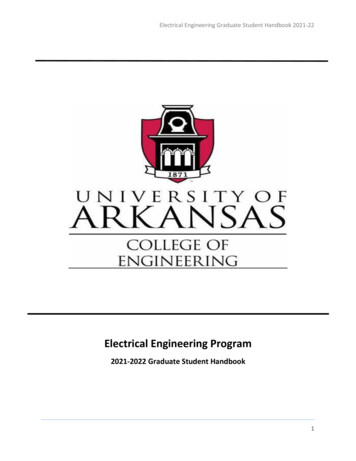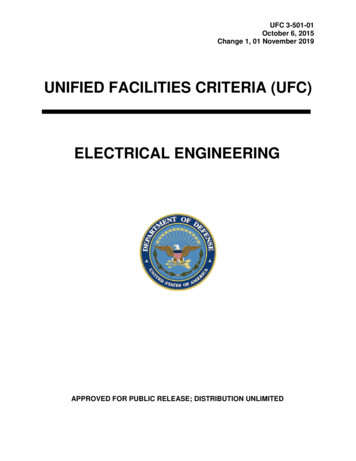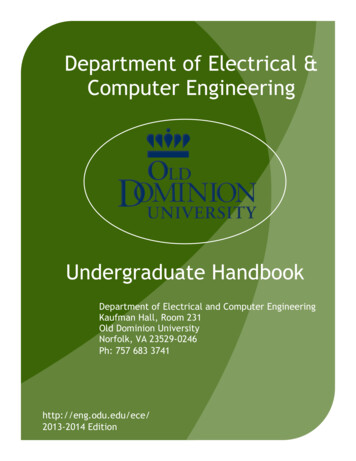
Transcription
Electrical Engineering 112026105Lecture 3Methods of Analysis
Methods of Analysis3.13.23.33.43.53.63.7MotivationNodal analysis.Nodal analysis with voltage sources.Mesh analysis.Mesh analysis with current sources.Nodal and mesh analysis by inspection.Nodal versus mesh analysis.2
3.1 Motivation (1)If you are given the following circuit, how can wedetermine (1) the voltage across each resistor, (2) currentthrough each resistor. (3) power generated by each currentsource, etc.What are the things which we need to know inorder to determine the answers?3
3.1 Motivation (2)Things we need to know in solving anyresistivecircuitCurrentwith currentvoltage Kirchhoff’sLawsand(KCL)sources only: Kirchhoff’s Voltage Laws (KVL) Ohm’s LawHow should we apply theselaws to determine the answers?4
3.2 Nodal Analysis (1)It provides a general procedure for analyzingcircuits using node voltages as the circuit variables.Example 135
3.2 Nodal Analysis (2)Steps to determine the node voltages:1. Select a node as the reference node.2. Assign voltages v1,v2, ,vn-1 to the remaining n-1nodes. The voltages are referenced with respectto the reference node.3. Apply KCL to each of the n-1 non-referencenodes. Use Ohm’s law to express the branchcurrents in terms of node voltages.4. Solve the resulting simultaneous equations toobtain the unknown node voltages.6
3.2 Nodal Analysis (3)Example 2 – circuit independent current source onlyApply KCL at node 1 and 2V1V23*Refer to in-class illustration, textbook, answer V1 -2V, V2 -14V7
3.2 Nodal Analysis (4)Example 3 – current with dependent current source*Refer to in-class illustration, textbook,answer v1 4.8V, v2 2.4V, v3 -2.4V8
3.3 Nodal Analysis with Voltage Source (1)Example 4 –circuit with independent voltage sourceHow to handle the 2V voltage source?9
3.3 Nodal Analysis with Voltage Source (2)A super-node is formed by enclosing a (dependentor independent) voltage source connectedbetween two non-reference nodes and anyelements connected in parallel with it.*Note: We analyze a circuit with super-nodesusing the same three steps mentioned aboveexcept that the super-nodes are treated differently.10
3.3 Nodal Analysis with Voltage Source (3)Basic steps:1. Take off all voltage sources in supernodes and apply KCL to super-nodes.2. Put voltage sources back to the nodesand apply KVL to relative loops.11
3.3 Nodal Analysis with Voltage Source (4)Example 5 – circuit with independent voltage sourceSuper-node 2-i1-i2-7 0Apply KVL v1 2-v2 012
3.3 Nodal Analysis with Voltage Source (5)Example 6 – circuit with two independent voltage sources13
3.3 Nodal Analysis with Voltage Source (6)Example 7 – circuit with two independent voltage sources-i1-i2 i3 0-i3-i5-i4 i1 0v1-20-v2 0v3-3vx-v4 014
3.4 Mesh Analysis (1)1. Mesh analysis provides another generalprocedure for analyzing circuits using meshcurrents as the circuit variables.2. Nodal analysis applies KCL to findunknown voltages in a given circuit, whilemesh analysis applies KVL to find unknowncurrents.3. A mesh is a loop which does not contain anyother loops within it.15
3.4 Mesh Analysis (2)Steps to determine the mesh currents:1. Assign mesh currents i1, i2, , in to then meshes.2. Apply KCL to each of the n meshes. UseOhm’s law to express the voltages in termsof the mesh currents.3. Solve the resulting n simultaneous equationsto get the mesh currents.16
3.4 Mesh Analysis (3)Example 8 – circuit with independent voltage sourcesNote:i1 and i2 are mesh current (imaginative, not measurable directly)I1, I2 and I3 are branch current (real, measurable directly)I1 i1; I2 i2; I3 i1 - i217
3.4 Mesh Analysis (4)Example 9 – circuit with dependent voltage source*Refer to textbook, answer Io 1.5A18
3.5 Mesh Analysis with Current Source (1)Circuit with current sourceA super-mesh results when two meshes have a (dependent orindependent) current source in common as shown in (a). Wecreate a super-mesh by excluding the current source and anyelements connected in series with it as shown in (b).19
3.5 Mesh Analysis with Current Source (2)The properties of a super-mesh:1. The current source in the super-mesh is notcompletely ignored; it provides theconstraint equation necessary to solve forthe mesh currents.2. A super-mesh has no current of its own.3. A super-mesh requires the application ofboth KVL and KCL.20
3.6 Nodal&Mesh Analysis w/ Inspection(1)The properties of a super-mesh:1. The current source in the super-mesh is notcompletely ignored; it provides the constraintequation necessary to solve for the meshcurrents.2. A super-mesh has no current of its own.3. A super-mesh requires the application of bothKVL and KCL.21
3.6 Nodal&Mesh Analysis w/ Inspection(2)Example 10 – By inspection, write the nodal voltage equationsfor the circuit22
3.6 Nodal&Mesh Analysis w/ Inspection(3)Example 11 – By inspection, write the mesh-current equationsfor the circuit23
3.7 Nodal versus Mesh Analysis (1)To select the method that results in the smaller number ofequations. For example:1. Choose nodal analysis for circuit with fewer nodes thanmeshes.*Choose mesh analysis for circuit with fewer meshes thannodes.*Networks that contain many series connected elements,voltage sources, or supermeshes are more suitable formesh analysis.*Networks with parallel-connected elements, currentsources, or supernodes are more suitable for nodalanalysis.2. If node voltages are required, it may be expedient to applynodal analysis. If branch or mesh currents are required, itmay be better to use mesh analysis.24
3.4 Mesh Analysis (1) 15 1. Mesh analysis provides another general procedure for analyzing circuits using mesh currents as the circuit variables. 2. Nodal analysis applies KCL to find unknown voltages in a given circuit, while mesh analysis applies KVL to find unknown currents. 3. A mesh is a loop which does not contain any other loops within it.










